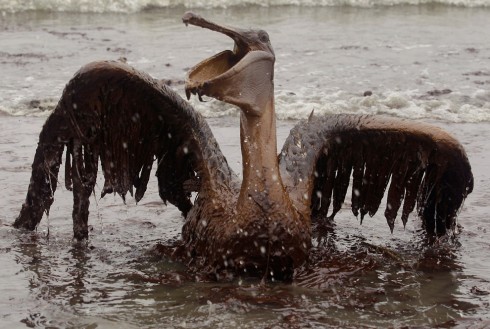An iconographic and text archive related to communication, technology and art.

Via Boston.com / The Big Picture: A Brown Pelican is seen on the beach at East Grand Terre Island along the Louisiana coast on Thursday, June 3, 2010. (AP Photo/Charlie Riedel)
I first found this photo over at Washington’s Blog. The post where it appears makes a (short) argument about the ban of media coverage apparently imposed by BP and US officials and the alleged suspension of the 1st Amendment of the US Constitution it represents (it links to another blog for a longer argument about this issue). At the very end of the post, the author seems to put forward a legal point supporting the publication of such pictures as the one shown above:
In addition, use of such images is also protected under the First Amendment to the United States Constitution. Specifically, reproduction is protected under the “Mai Lai/Zapruder line of cases”, since:
(1) The images are of historical significance;
(2) They show facts which cannot be conveyed effectively in any other manner, and
(3) Therefore the Constitution trumps copyright law. (more)
Now, what exactly are those “Mai Lai/Zapruder line of cases” ? It’s not a law, but a “line of cases” and it could plausibly be used to challenge the ban of some media access to the site of the disaster (see The New York Times: “BP and Officials Block Some Coverage of Golf Oil Spill”). How? Under the jurisprudence constante or the stare decisis legal principle (it depends of the number of cases won using the same argument). Here’s an example of such a case: Los Angeles News Service, Robert Tur v. Frank Tullo; Charles Bicket; Audio Video Reporting Services (1992).
The heart of this case heavily relies on the work of Professor Melville B. Nimmer (1923-1985) who’s still consider today as the authority on copyright laws. More precisely, the argument ask for a suspension of the idea/expression dichotomy on which copyright laws traditionally rely:
Copyright law incorporates First Amendment goals by ensuring that copyright protection extends only to the forms in which ideas and information are expressed and not to the ideas and information themselves.
Indeed, Professor Nimmer had suggested in the past that in some exceptional circumstances, the dichotomy between the content (idea) and it’s form (expression) doesn’t serve adequately the First Amendment. There are cases where the value of the expression is more important to the public than the idea it could express:
Professor Nimmer has suggested the idea-expression dichotomy and the fair use doctrine may not adequately protect First Amendment interests in some circumstances. 1 Nimmer @ 1.10[C][2], at 1 – 81. Citing the exclusive photographs of the My Lai massacre during the Vietnam War and the Zapruder home movie of the assassination of President John Kennedy as examples, Nimmer proposes that “where the ‘idea’ of a work contributes almost nothing to the democratic dialogue, and it is only its expression which is meaningful,” copyright protection of the expression should be limited in the interest of public access to information necessary to effective public dialogue. Id. at 1 – 82-1 – 84. Nimmer explains:
No amount of words describing the “idea” of the massacre could substitute for the public insight gained through the photographs. The photographic expression, not merely the idea, became essential if the public was to fully understand what occurred in that tragic episode. It would be intolerable if the public’s comprehension of the full meaning of My Lai could be censored by the copyright owner of the photographs. . . .
For what I understand, it means two things. First, that in certain circumstances the idea of the creator or less important than the form he creates (that is : what he gives form to, or what he in-forms: thus the concept of information). For example, Zapruder’s ideas about what he wanted to film, how he wanted to film it, what he wanted to say are less important than the raw (but this is problematic) expression of the event he caught on film. Second, that this expression is of public interest since the idea of the assassination could not be convey with the same efficiency by another form (a textual description for example). Therefore, the expression should fall under the Fair Use doctrine.
I should add that I’m not a lawyer and that I don’t know much about US copyright laws. I’m more interested in this “dichotomy” between the idea and it’s expression. I find it problematic, to say the least. The exceptions represented by the “Mai Lai/Zapruder line of cases” may be approached from the perspective of the relation between the medium and the message (be it in law, in sociology, in philosophy or in communication studies, with or without McLuhan in mind).
- By Philippe Theophanidis
- on
- ― Published in Art, Communication, Photography, Technology
- Tagged: animal, British Petroleum, catastrophe, constitution, content, disaster, expression, fair use, form, freedom, human, idea, image, law, medium, message, press, representation, shock, United-States, Zapruder
